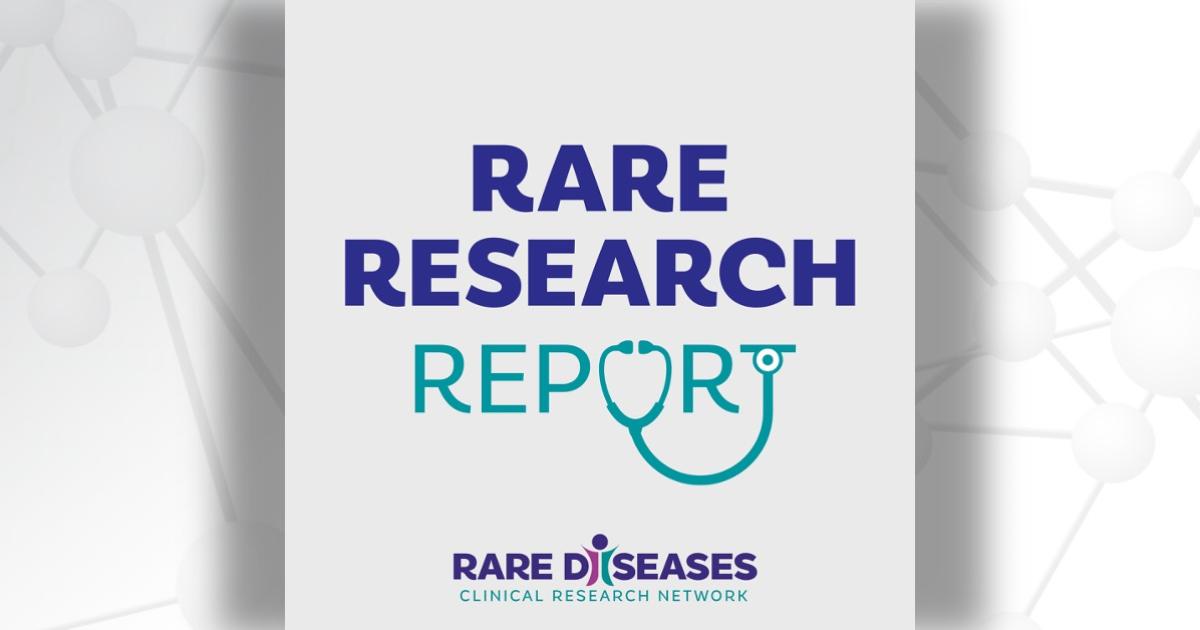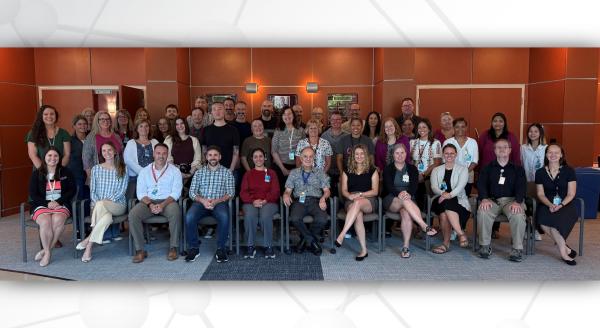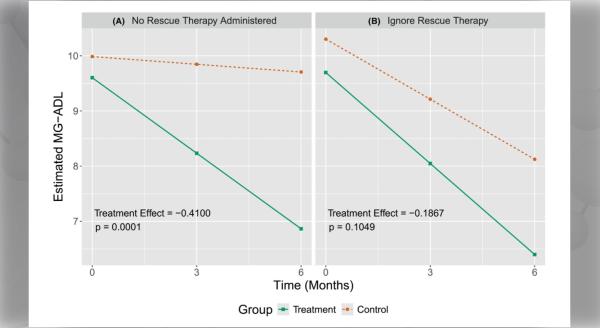Each month, we share summaries of recent Rare Diseases Clinical Research Network (RDCRN) grant-funded publications. Catch up on the latest RDCRN research below.
Jump to:
- Developmental Synaptopathies Consortium (DSC)
- Frontiers in Congenital Disorders of Glycosylation Consortium (FCDGC)
- Inherited Neuropathy Consortium (INC)
- Porphyrias Consortium (PC)
- Urea Cycle Disorders Consortium (UCDC)
Listen to these summaries on the Rare Research Report podcast.
Developmental Synaptopathies Consortium (DSC)
Exploring the Safety and Efficacy of Everolimus in PTEN Hamartoma Tumor Syndrome
PTEN hamartoma tumor syndrome (PHTS) is a complex neurodevelopmental disorder characterized by overactivity of the mechanistic target of rapamycin (mTOR) pathway, which serves as a major regulator of growth. Limited data suggest that mTOR inhibitors may be therapeutic for patients with PHTS. However, no placebo-controlled studies have explored the effects of mTOR inhibition on cognition and behavior in PHTS patients with or without autism.
In this study, researchers conducted a phase II, placebo-controlled trial to examine the safety and efficacy of everolimus, an mTOR inhibitor, in patients with PHTS. The team measured cognitive and behavioral outcomes in addition to biomarkers of electroencephalography (measurement of electrical activity in different parts of the brain).
Results show that everolimus was well tolerated in individuals with PHTS. Electroencephalography supported engagement of the drug target in the brain, and some of the secondary (but not primary) outcome measures moved in the direction of improvement. Although this trial provides early evidence that everolimus is safe for use in patients with PHTS, authors note that further study is needed.
Srivastava S, Jo B, Zhang B, Frazier T, Gallagher AS, Peck F, Levin AR, Mondal S, Li Z, Filip-Dhima R, Geisel G, Dies KA, Diplock A, Eng C, Hanna R, Sahin M, Hardan A; Developmental Synaptopathies Consortium. A randomized controlled trial of everolimus for neurocognitive symptoms in PTEN hamartoma tumor syndrome. Hum Mol Genet. 2022 Oct 10;31(20):3393-3404. doi: 10.1093/hmg/ddac111. PMID: 35594551.
Frontiers in Congenital Disorders of Glycosylation Consortium (FCDGC)
Exploring the Role of NGLY1 Deficiency in Patients with NGLY1-Congenital Disorder of Deglycosylation
NGLY1-CDDG (congenital disorder of deglycosylation) is a multisystemic, inherited condition caused by a mutation in the NGLY1 gene. Although the NGLY1 enzyme plays an essential role in the process of deglycosylation, the effects of NGLY1 deficiency on protein glycosylation are not yet understood.
In this study, researchers explored the hypothesis that NGLY1 deficiency leads to accumulation of misfolded glycoproteins. Using glycoproteomics and proteomics methods, the team analyzed fibroblasts from four patients with NGLY1 deficiency carrying different variants in NGLY1.
Results showed no significant accumulation of glycoproteins in the NGLY1-deficient fibroblasts. However, researchers found distinct changes in specific glycoproteins. As the first study of its kind, authors note that these findings highlight new insights for understanding NGLY1-CDDG.
Budhraja R, Saraswat M, De Graef D, Ranatunga W, Ramarajan MG, Mousa J, Kozicz T, Pandey A, Morava E. N-glycoproteomics reveals distinct glycosylation alterations in NGLY1-deficient patient-derived dermal fibroblasts. J Inherit Metab Dis. 2022 Sep 14. doi: 10.1002/jimd.12557. Epub ahead of print. PMID: 36102038.
DDOST-CDG is an ultra-rare type of congenital disorder of glycosylation (CDG) that is caused by mutations in the gene DDOST. The metabolic disorder was previously reported in just two patients, whose clinical features included severe developmental delay, failure to thrive, and hypotonia (low muscle tone). Both patients also had abnormal transferrin glycosylation.
In this study, researchers describe a new patient with DDOST-CDG. The 18-year-old male presented with moderate developmental delay, progressive opsoclonus (involuntary, rapid eye movements), myoclonus (involuntary, sudden muscle spasms), ataxia (impaired balance or coordination), tremor, and dystonia (involuntary muscle contractions that cause repetitive or twisting movements). The team performed several tests, including biochemical studies, exome sequencing, plasma N-glycan profiling, and western blot analysis, to learn more about the patient’s clinical features.
Authors state that these insights—including new findings on the clinical variability, phenotypes, and genotypes of DDOST-CDG—are essential for diagnosing and managing patients with DDOST-CDG.
Elsharkawi I, Wongkittichote P, Daniel EJP, Starosta RT, Ueda K, Ng BG, Freeze HH, He M, Shinawi M. DDOST-CDG: Clinical and molecular characterization of a third patient with a milder and a predominantly movement disorder phenotype. J Inherit Metab Dis. 2022 Oct 10. doi: 10.1002/jimd.12565. Epub ahead of print. PMID: 36214423.
Inherited Neuropathy Consortium (INC)
Describing Autonomic Characteristics in RFC1-related Disease with Parkinsonism
Recently, biallelic (both alleles of a single gene) expansions in the RFC1 gene have been found to cause several neurological disorders in addition to a form of inherited neuropathy known as CANVAS (cerebellar ataxia, neuropathy, and vestibular areflexia syndrome). There are also descriptions of Parkinsonism and a multiple system atrophy (MSA)-like syndrome. However, the profile of the autonomic nervous system in a patient with CANVAS/MSA-like overlap syndrome had not yet been fully characterized.
In this study, researchers present the first detailed description of autonomic characteristics in a patient with multisystem RFC1-related disease. Initially presenting with CANVAS, the patient developed Parkinsonism, cardiovascular failure, and severe autonomic failure similar to classical MSA.
Results suggest that patients with an MSA-like syndrome, plus signs of vestibular (balance) failure or sensory neuropathy, should be tested for the RFC1 expansion. Authors also note that the link between MSA and CANVAS should be further explored.
Record CJ, Alsukhni RA, Curro R, Kaski D, Rubin JS, Morris HR, Cortese A, Iodice V, Reilly MM. Severe distinct dysautonomia in RFC1-related disease associated with Parkinsonism. J Peripher Nerv Syst. 2022 Sep 30. doi: 10.1111/jns.12515. Epub ahead of print. PMID: 36177974.
Neuromyotonia and axonal neuropathy (NMAN) is a rare peripheral neuropathy and subtype of Charcot-Marie-Tooth disease. NMAN is characterized by damage to nerve axons (nerve ends) and overactivation of peripheral nerves. The disease is caused by mutations in the HINT1 gene, which are among the most common causes of recessive neuropathy. Most patients with NMAN are found to have an HINT1 variant that has spread throughout Eurasia and America.
In this study, researchers performed the first analysis of NMAN in Lithuania. The team identified eight patients from 46 families with variations in the HINT1 gene, including a new variant. Study participants showed typical symptoms associated with NMAN (such as motor impairment in lower limbs), but also some atypical features (such as developmental delay and mood problems).
In addition to expanding the understanding of NMAN, these findings may help diagnose inherited neuropathies in the Baltic region and beyond. Authors note that study results could also impact future therapeutic strategies, as a patient’s specific genetic mutation will determine their treatment options.
Malcorps M, Amor-Barris S, Burnyte B, Vilimiene R, Armirola-Ricaurte C, Grigalioniene K, Ekshteyn A, Morkuniene A, Vaitkevicius A, De Vriendt E, Baets J, Scherer SS, Ambrozaityte L, Utkus A, Jordanova A, Peeters K. HINT1 neuropathy in Lithuania: clinical, genetic, and functional profiling. Orphanet J Rare Dis. 2022 Oct 14;17(1):374. doi: 10.1186/s13023-022-02541-0. PMID: 36242072; PMCID: PMC9569031.
Porphyrias Consortium (PC)
Erythropoietic protoporphyria (EPP) and X-linked protoporphyria (XLP) are rare, inherited, metabolic disorders characterized by build-up of porphyrins. Porphyrins are substances that bind metals to form complexes, such as the iron found in red blood cells. The hallmark symptoms include phototoxicity (severe pain during light exposure) and photosensitivity (skin hyperreactivity to light). Due to the rarity of EPP and XLP, physicians often have limited expertise with these disorders, which can lead to delays in diagnosis.
In this study, researchers developed evidence-based consensus guidelines for the diagnosis, monitoring, and management of EPP and XLP. First, the team conducted a systematic literature review. Next, they divided topics among subcommittees of experts to reach a consensus on guidelines.
The new guidelines discuss biochemical and genetic testing for diagnosis, prevention of symptoms, management of acute phototoxicity, and pharmacologic (drug or medication) and non-pharmacologic treatment options. Researchers also discuss management, including the importance of ongoing monitoring, guidance on pregnancy and surgery, and the safety of other therapies. Authors note that these guidelines can aid in early diagnosis and management of these disorders.
Dickey AK, Naik H, Keel SB, Levy C, Beaven SW, Elmariah SB, Erwin AL, Goddu RJ, Hedstrom K, Leaf RK, Kazamel M, Mazepa M, Philpotts LL, Quigley J, Raef H, Rudnick SR, Saberi B, Thapar M, Ungar J, Wang B, Balwani M; Porphyrias Consortium of the Rare Diseases Clinical Research Network. Evidence-based consensus guidelines for the diagnosis and management of erythropoietic protoporphyria and X-linked protoporphyria. J Am Acad Dermatol. 2022 Aug 27:S0190-9622(22)02611-1. doi: 10.1016/j.jaad.2022.08.036. Epub ahead of print. PMID: 36041558.
Urea Cycle Disorders Consortium (UCDC)
Ornithine transcarbamylase deficiency (OTC-D) is an X-linked disorder and the most common type of urea cycle disorder. Patients with OTC-D can present with a variable spectrum of disease severity, ranging from no symptoms to lethal hyperammonemia (high blood ammonia levels). Therefore, predicting disease course at an early stage is important to personalize therapies for individual patients, which can include medical treatment or liver transplantation.
In this study, researchers developed a new cell-based system to assess the residual enzyme activity associated with various disease-causing genetic changes in the OTC gene. Using this system, they were able to correlate residual enzymatic OTC activities with clinical and biochemical outcome parameters of 119 male individuals with OTC-D.
Results show that residual enzymatic OTC activity can distinguish individuals with a severe form of OTC-D from those with milder forms of the disorder. As a reliable predictor of disease severity in OTC-D, this classification system could help guide therapeutic strategies and counseling of patients and parents.
Scharre S, Posset R, Garbade SF, Gleich F, Seidl MJ, Druck AC, Okun JG, Gropman AL, Nagamani SCS, Hoffmann GF, Kölker S, Zielonka M; Urea Cycle Disorders Consortium (UCDC) and the European registry and network for Intoxication type Metabolic Diseases (E-IMD) Consortia Study Group. Predicting the disease severity in male individuals with ornithine transcarbamylase deficiency. Ann Clin Transl Neurol. 2022 Oct 10. doi: 10.1002/acn3.51668. Epub ahead of print. PMID: 36217298.
The Rare Diseases Clinical Research Network (RDCRN) is funded by the National Institutes of Health (NIH) and led by the National Center for Advancing Translational Sciences (NCATS) through its Division of Rare Diseases Research Innovation (DRDRI). Now in its fourth five-year funding cycle, RDCRN is a partnership with funding and programmatic support provided by Institutes, Centers, and Offices across NIH, including the National Institute of Neurological Disorders and Stroke, the National Institute of Allergy and Infectious Diseases, the National Institute of Diabetes and Digestive and Kidney Diseases, the Eunice Kennedy Shriver National Institute of Child Health and Human Development, the National Institute of Arthritis and Musculoskeletal and Skin Diseases, the National Heart, Lung, and Blood Institute, the National Institute of Dental and Craniofacial Research, the National Institute of Mental Health, and the Office of Dietary Supplements.






